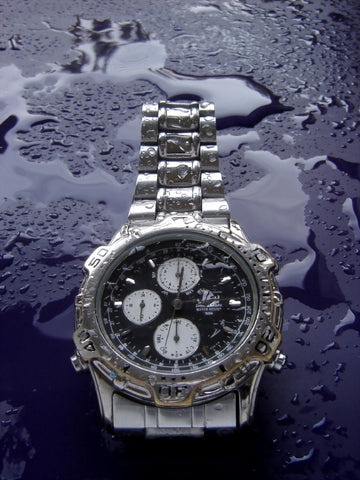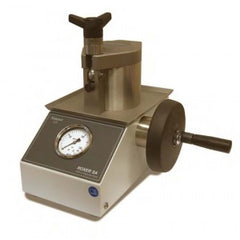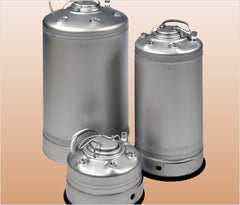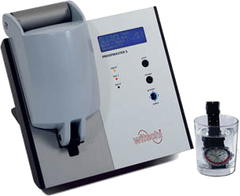Water Resistance and Watch Pressure Testing
 What makes a watch water-resistant?
What makes a watch water-resistant?
“But my watch is waterproof!”How many times have you seen an SUV upside-down in a ditch after the first snow fall? That idiot is hanging by the seatbelts in Dad's Lamborghini LM002 because he didn't know what the capacities and limitations of 4-wheel-drive vehicle actually are.
“Waterproof” watches can get you in the same kind of trouble. When we properly say a watch is water resistant, all we
mean is that the case has the ability to exclude water to a certain depth – and for our purposes, when we say depth we mean pressure.
The watch industry has largely abandoned the term “waterproof,” even for its professional diving pieces. It's a false promise, and owing to legal guidelines set by the Federal Trade Commission and the International Organization for Standardization, we are barred from making it.[1] There is always a way for water to get inside your watch, and the challenge for the this industry (and your humble servants at TimescapeUSA) is to constrain it however we can.
“But my watch is waterproof!”
How many times have you seen an SUV upside-down in a ditch after the first snow fall? That idiot is hanging by the seatbelts in Dad's Lamborghini LM002 because he didn't know what the capacities and limitations of 4-wheel-drive vehicle actually are. "Waterproof" watches can get you in the same kind of trouble. When we properly say a watch is water resistant all we mean is that the case has the ability to exclude water to a certain depth – and for our purposes, when we say depth we mean pressure.
The watch industry has largely abandoned the term “waterproof,” even for its professional diving pieces. It's a false promise, and owing to legal guidelines set by the Federal Trade Commission and the International Organization for Standardization, we are barred from making it.[1] There is always a way for water to get inside your watch, and the challenge for the this industry (and your humble servants at TimescapeUSA) is to constrain it however we can.
“What makes a watch water-resistant?”
Every seam in a watch's exterior is a potential leak, which makes the crown, crystal, pushers, and case back our chief offenders. The solution is to create a water resistant seal at each of these locations. Precision CAD case-making, screw-tight crowns, and rubber gaskets make even casual wear pieces better able to resist water than anything fashioned by George Daniels or Abraham-Louis Breguet.
A dive watch designed for serious depth is supplemented by heavier gasketing, thicker case components, and a screw-in case back. The addition of a special valve compensates for sudden increases in internal pressure that could explode a rapidly resurfacing watch.

Quantifying Water Resistance
Your water resistant piece is marked with a rating on the dial or case back. The value will be expressed in feet, meters, or atmospheres, and it alludes to the maximum safe water depth for your watch. But what do these numbers really mean?Importantly, the rating is not a guarantee. Just like the CBO's latest budget projections, it applies in specific, almost unlikely conditions. Is the watch immobile, or is it under dynamic pressure? What is the salinity of the water, and its temperature? How rapid was the change in pressure from sea level? How long has the watch been immersed? These factors can all detract from the watch's performance and complicate our understanding of its use.
For our clients in the field, TimescapeUSA offers these suggestions:[2]
[1] ISO 2281 Horology – Water-Resistant Watches
[2] There are numerous resources on the web regarding dive and water resistant watches. Much of this guide is taken from the Jewellers and Watchmakers of New Zealand Incorporated website. http://www.jwnz.co.nz/page/watches.aspx
| 3ATM or 30m |
Watch is sealed against splashes, rain and very brief immersion. The watch is not suitable for showering, swimming, or diving. |
| 5ATM or 50m |
Watch is sealed against immersion at the surface and is suitable for swimming. Watch is not suitable for snorkeling, diving, or water sports. |
| 10ATM or 100m |
Watch can tolerate immersion as well as some dynamic pressure, and is suitable for snorkeling and water sports. Watch is not suitable for diving. |
| 20ATM or 200m |
Watch is suitable for extreme water sports and skin diving. |
Professionally rated “Dive Watches” have a different set of guidelines regulated by the ISO 6425 – Divers' Watches International Standard:
| Diver's 100m |
Minimum ISO 6425 depth for scuba diving. Not suitable for saturation diving. |
| Diver's 200-300m |
Suitable for scuba diving. Not suitable for saturation diving. |
| Diver's 300m+ |
Suitable for saturation diving (helium enriched environment). Watch will be marked “DIVER'S WATCH LM FOR MIXED-GAS DIVING” |
Testing Water Resistance
 Even if you don't earn your bread repairing oil pipeline off the coast of Malaysia, the cost of a water intrusion event can be high – up to the replacement cost of the watch itself. The industry has developed testing protocols to help evaluate
Even if you don't earn your bread repairing oil pipeline off the coast of Malaysia, the cost of a water intrusion event can be high – up to the replacement cost of the watch itself. The industry has developed testing protocols to help evaluate
the water resistance of your piece and avoid a bad outcome.
Wet Pressure Testing is the submersion of the watch with artificially induced pressure. The empty case is pressurized a certain amount past its rated safe depth, maintained at pressure for anywhere between 30 minutes and a number of hours, depressurized, and then heated. If cooling results in condensation on the inside of the crystal, it can be deduced that the
case has failed.
At TimescapeUSA we use different machines to perform our wet pressure testing. The Bergeon 5555/98 Wet Pressure Tester can reliably generate 3ATM, as well as creating pressure differentials for observing leaks. Our Alloy Products Pressure Vessel can be driven to over 10ATM, and will accommodate up to four pieces at a time. With the Rozer Natator 125, we can pressurize your case to 125ATM – over 1200 meters of water pressure, and fully capable of smashing a lesser watch (or a human diver) flat.
 Dry Pressure Testing is safer and more convenient. Inside a closed vessel, the case is held in a sensitive clamp, which measure minute variations in the size with changes in air pressure. When these variations fall outside of specific industry parameters, the watch is judged a failure. Because the test involves no actual water, the watch movement can remain in the case.
Dry Pressure Testing is safer and more convenient. Inside a closed vessel, the case is held in a sensitive clamp, which measure minute variations in the size with changes in air pressure. When these variations fall outside of specific industry parameters, the watch is judged a failure. Because the test involves no actual water, the watch movement can remain in the case.
We are quite proud here at TimescapeUSA of our Witschi Proofmaster S. It is capable of dry pressure testing up to 10ATM, and cycles in a matter of minutes. This is fully sufficient to evaluate gasket integrity after a watch has been opened for repair, or as a prophylactic against future problems.
“When should I have my watch tested?”
Any time a water resistant watch is opened, after being closed again it should be dry pressure tested to insure that the gaskets have seated properly. This is a service that any reputable watchmaker will perform automatically. A properly done pressure test does no damage to the watch – in the case of a dry test, the case back need not even be opened and takes only a few minutes.Dive watches and other pieces that are regularly worn at pressure or while swimming should be more strenuously wet tested at least once per year. Expect to need new gaskets within the normal service interval of the piece, every 4 to 7 years depending on the watch and circumstances.
TimescapeUSA also recommends that the client have his or her watch evaluated for water resistance any time the watch suffers a potentially damaging event. A hard shock can disrupt a gasket, especially if there is conspicuous damage to the case or crown. Gaskets lose their elasticity and will need replacement within the normal service interval of your piece, especially crown gaskets.
Finally, it needs to be said that the client is the watch's greatest threat. If a screw-down crown is left open when the watch is submersed, horrible damage is usually the result. Similarly, none of a watch's functions should be used while the watch is wet, as this can force water inside the case. And last but not least, avoid prolonged exposure of any watch to hot water or detergents. Soapy showers are dangerous, and that relaxing soak in the hot tub may cost you thousands of dollars in service.

 What makes a watch water-resistant?
What makes a watch water-resistant?